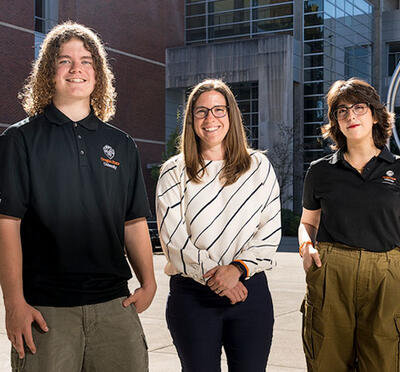Thirty years ago, Jen-Hsun “Jensen” Huang arrived at Oregon State University as a shy and introverted 16-year-old kid ready to study electrical engineering.
Last week, Huang returned to his alma mater for his induction into the College of Engineering’s Hall of Fame, the highest echelon of the Oregon Stater Awards, which honor outstanding OSU engineering alumni.
While on campus, Huang (1984, BSEE) took time to talk with students and reflect back on his trajectory from a skinny, socially awkward student living in McNary Hall to a high-tech superstar whose company employs 8,000 people, holds more than 5,000 U.S. patents granted and pending, and has its ubiquitous graphics processing technologies embedded in everything from smartphones and supercomputers to NASA workstations and new cars.
Huang is co-founder, president and CEO of NVIDIA, the company that invented the graphics processing unit (GPU) in 1999, is one of the world’s most respected technology companies today and is celebrating its 20th anniversary this month.
Speaking from the steps in the Kelley Engineering Center’s four-story atrium that bears his and his wife Lori’s names, Huang talked about the role serendipity plays in success—from business to marriage.
“In no small way am I saying serendipity matters a lot to success,” Huang told the mostly male audience, after describing how he met his future wife, Lori Mills, in a class of 80 engineering students where she was one of only three women.
He said serendipity also played a role in the people he was able to meet early in his career, including his two co-founders of NVIDIA (Chris Malachowsky and Curtis Priem) and Andy Bechtolscheim, co-founder of Sun Microsystems, the first investor in Google and the person Huang referred to as “the most important modern computer architect.”
“If not for the expertise I’d developed using design tools on microprocessors and computers at my first two jobs out of college, my relationship with Andy wouldn’t have started,” said Huang, who worked with Bechtolscheim on the Sun SPARCstation prior to founding NVIDIA. “He was looking for someone who could help him realize his imagination in computers.”
Huang soon realized he himself was more interested in imagining a design process than a final product. “In college, I was so obsessed with building something that I didn’t think much about how to build things,” he said. But after working at Advanced Micro Devices and LSI Logic developing design tools to help chipmakers, Huang had an epiphany.
“I realized the real challenge is not what you’re trying to build, but how you go about building it.” This realization was at the heart of why he founded NVIDIA in 1993—to innovate a new process to design the world’s most advanced 3D graphics chip that would have the potential to “consumerize” computer graphics, so that it might become another medium for expressing ideas and telling stories.
Before they launched NVIDIA, Huang and his two co-founders asked themselves three simple questions: Is this work something they would “really, really love” to do? Is this work worthwhile doing? And is this work something that is “really hard” to do?
“Today, I ask myself those same three questions all the time,” Huang said. “Because you shouldn’t do anything you don’t love. And you should only work on things with your life that matter. And if it’s hard to do, you’ll attract people to your team who are the best in the world at what they do, so you’d better make darn sure the work you’re doing is worthy of their lives. Otherwise it makes no sense for them to be on your team, and if they’re not on your team, you can’t do great things.”
Although today NVIDIA is renowned for doing great things, the company nearly failed just two years after its launch when the price of DRAM memory free fell from $50 a megabyte to $5 and more than 80 competitor companies jumped into the 3D graphics chip race. The two years of intense design innovation NVIDIA had worked on to get around the high price of memory was suddenly irrelevant. Huang and his fledgling company had to scramble to reinvent itself, taking huge risks that ultimately paid off. “And the rest is history,” he says. “At NVIDIA, we still do important work we love that is hard to do.”
The top three things he gained from his time at Oregon State? The people he met, a lesson from a professor whose math drove him crazy, and the social skills he learned living in McNary Hall.
“For me, the number one person I met here was, undoubtedly, Lori,” he said. “Which was serendipity, of course.”
On the academic side, he credits Donald Amort for teaching him a life lesson he uses to this day. “Professor Amort always used only round numbers on the board in class, which drove me crazy, because we were working with exponents and numbers from the real world accurate to three decimal points. But I finally realized he was trying to teach us that while it’s good to know the details, you can’t lose sight of the big picture.” Today, Huang uses round numbers in his work at NVIDIA all the time. “The employees call it CEO math, but it is surprisingly accurate because you never lose sight of the most important variables. Professor Amort was really fantastic at teaching me that.”
The youngest student in his OSU dormitory, Huang picked up social skills by “living life” in McNary Hall, along with a little help from a friend he referred to as Henry Weinhard.
“It was living life, and to this day I would say that the social part of growing is as important as the academic part of growing, especially in my case because I was so introverted and shy,” he said. “It would have been hard for me to stand up here now and do this. It’s still hard, but it would have been impossible otherwise. Learning social skills was very important.”
The shy boy from Beaverton, Oregon, has clearly overcome his inhibition and risen to rock-star legend in the high-tech world.



